The Oireachtas Library holds more than 450 issues of The United Irishman, a newspaper written and edited by Jeremiah O’Donovan Rossa while he was exiled in New York in the late 19th century.
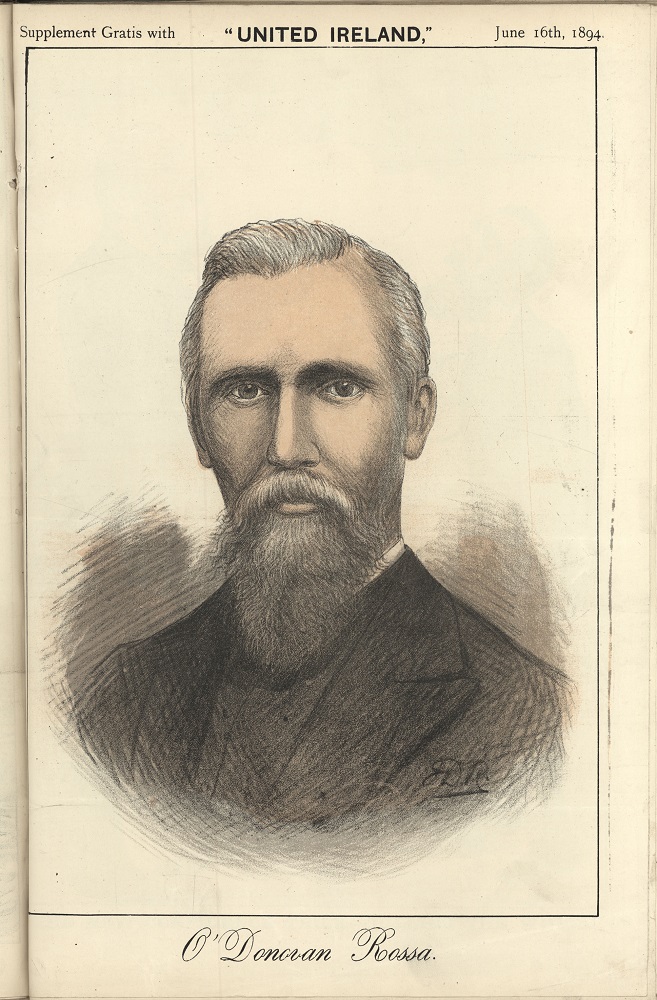
Portrait of O’Donovan Rossa from the Dublin-based United Ireland newspaper, 16 June 1894
Jeremiah O’Donovan Rossa (1831-1915) was an Irish Fenian. He was jailed several times by the British authorities for his political activities before being released as part of an amnesty in 1870. Not being permitted to remain in the United Kingdom he moved with his family to New York and founded a newspaper called The United Irishman in 1881. This ran to 1910 (though the Oireachtas Library’s collection dates only to 1900).
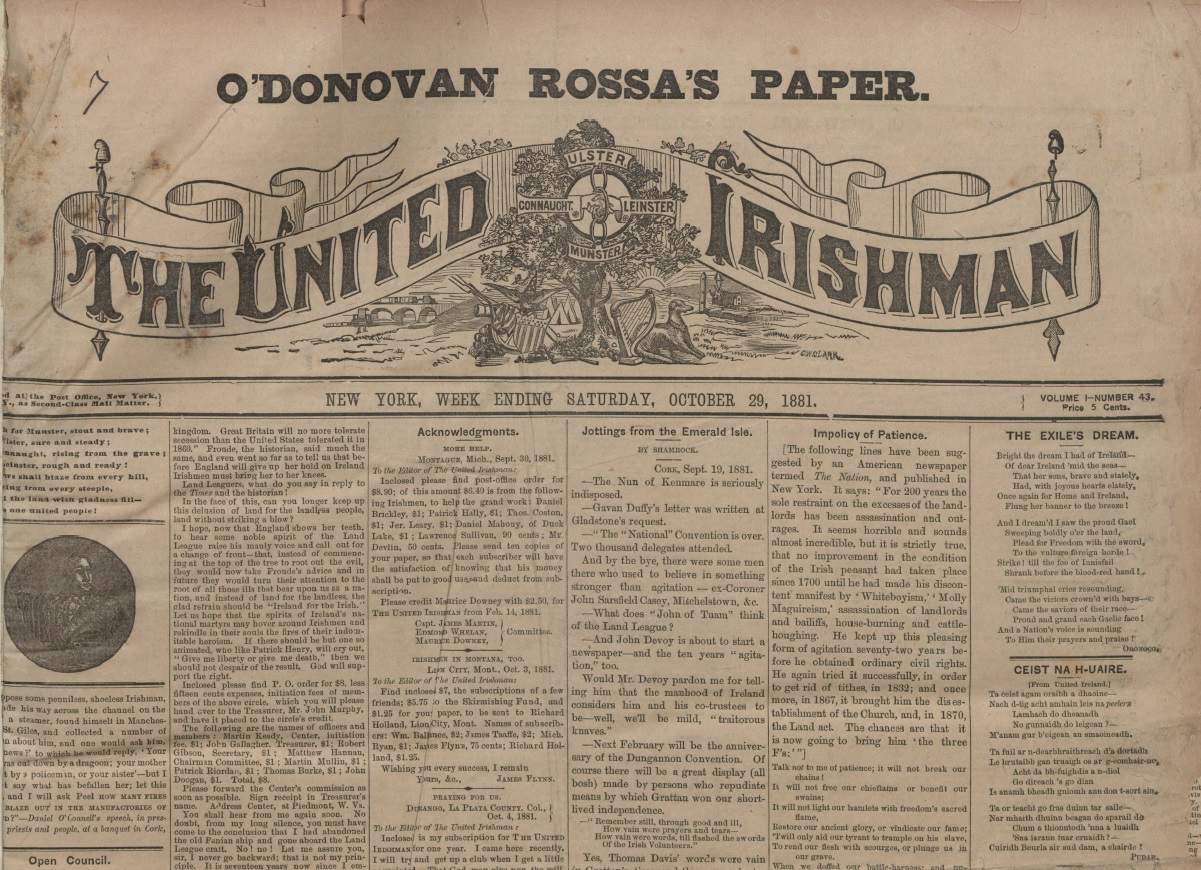
Early editions of The United Irishman also featured O’Donovan Rossa’s name above the masthead
The newspaper was available on both sides of the Atlantic. There was much transatlantic circulation of newspapers in the late 19th century. They were cheap to produce and buy, and with the rapid development of railways and steamships it became much easier and faster for information to be shared on an international scale. Many issues of O’Donovan Rossa’s newspaper were collected and stored by the Chief Secretary’s Office in Dublin Castle. Dublin Castle housed the main government administrative offices in Ireland, and it was from here that officials kept a close watch on revolutionary activities. The newspaper was part of the reference collection transferred from Dublin Castle to the Oireachtas Library in 1924.
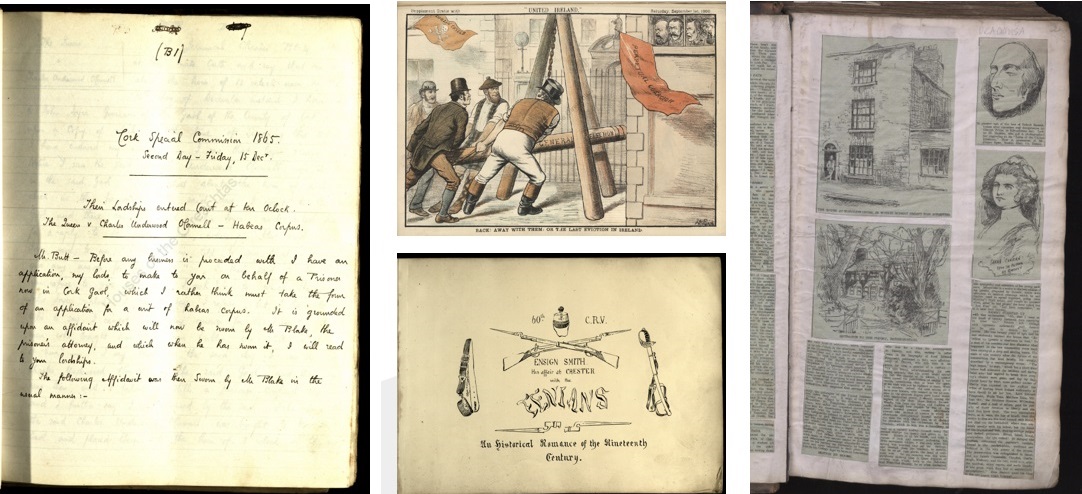
The Dublin Castle Collection features lots of Irish nationalist content, including handwritten Fenian trials, political cartoons and newspaper clippings related to Irish nationalism
As a propaganda outlet for Irish nationalism, the newspaper was a medium for raising awareness of the Irish nationalist cause. This included raising donations for O’Donovan Rossa’s ‘skirmishing fund’ – a source of funds for an armed Irish nationalist campaign. As a source of news, social events, letters, and cultural content, the paper also sought to maintain a strong bond between the Irish communities at home and abroad.
The Skirmishing Fund
O’Donovan Rossa was a proponent of ‘scientific warfare’ against the British, namely the use of dynamite bombs throughout England to force the British government to withdraw from Ireland. His stance was a controversial one even at that time, and particularly after the bombing campaign killed a young boy in 1881. It led to a split in his support from other nationalists, who favoured the constitutional route to Irish independence proposed by Charles Stewart Parnell (1846-91) and the Irish Parliamentary Party. It was also a likely reason for the attempted assassination of O’Donovan Rossa by an Englishwoman, Lucille Yseult Dudley (circa 1864-1947), in New York in 1885.
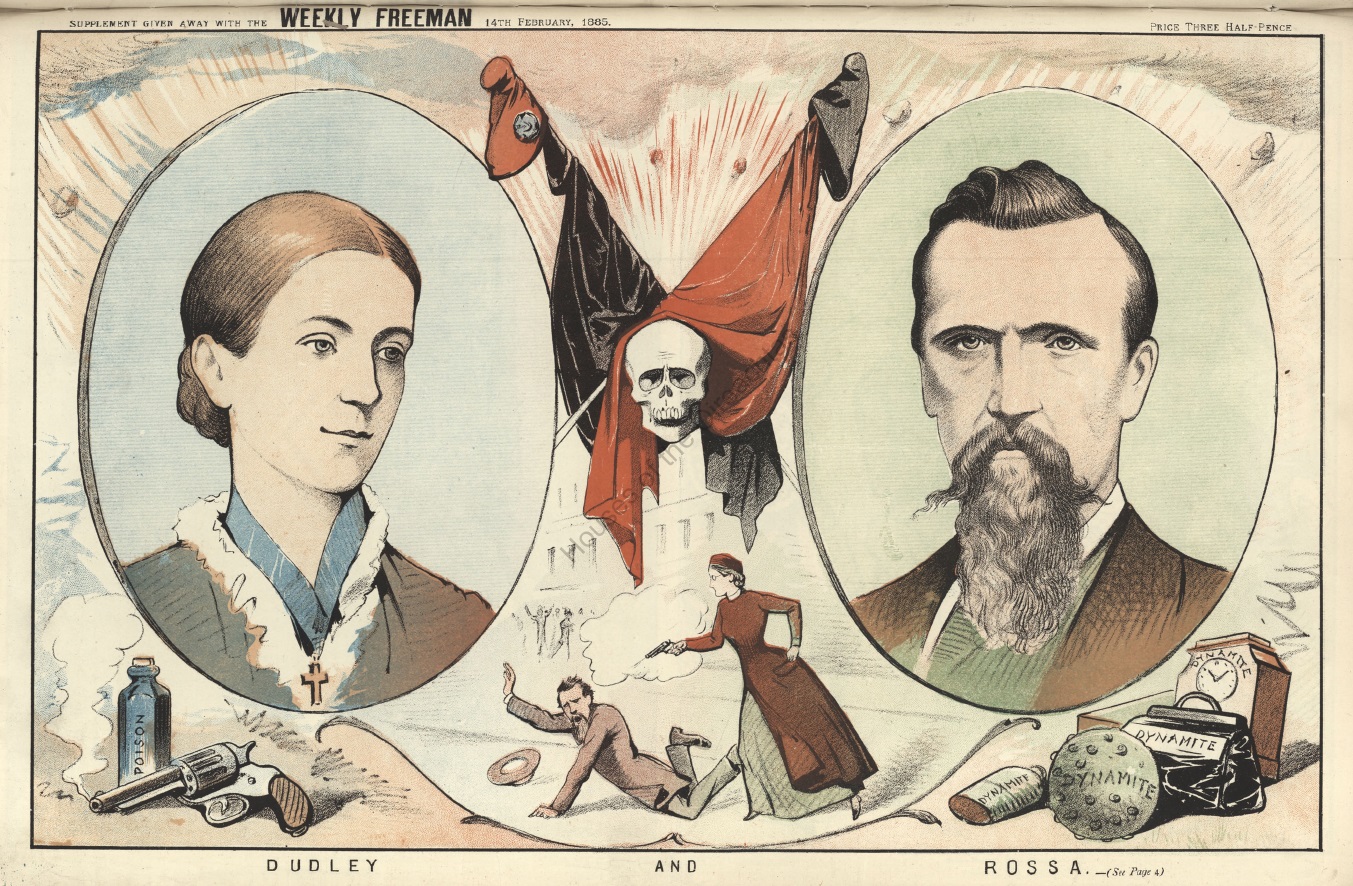
A cartoon from the Weekly Freeman newspaper, 14 February 1885, depicts the attempted assassination of O’Donovan Rossa in New York
The paper is full of anti-English language. O’Donovan Rossa’s personal recollections, columns and letters regularly portray his impatience with the disunion of Irish nationalists based in North America, and the slow pace of political progress in Ireland.
I would go a little heavier on the dynamite, but there is no order office closer than fifty miles from this out-of-the-way part of the Rockies that I am living in…
Much of the paper’s early content is in the form of letters from subscribers who also donated to the skirmishing fund. The strength of feeling among the paper’s readers is evident: In one letter from 1887, J.P. Quinlan in Colorado wrote that he was sorry he couldn’t send more money for dynamite but it was too difficult to access paper money in the remote area where he was living.

Letters to the editor demonstrate the widespread locations of Irish people all over the United States, as well as the widespread availability of the newspaper
Such extremism was published alongside songs, poems, jokes, cartoons, and advertisements. There was one story in the issue of 10 May 1890 about a well-attended discussion at the Women’s Press Club at Union Square on whether newspaper women should marry and whom. Another article in the issue of 29 December 1900 proclaimed that a German engineer had rendered it possible to use a phonograph instead of a guide at exhibitions. There were illustrated stories for children, including a tale in the issue of 21 March 1891 about a kitten that loved a duck.
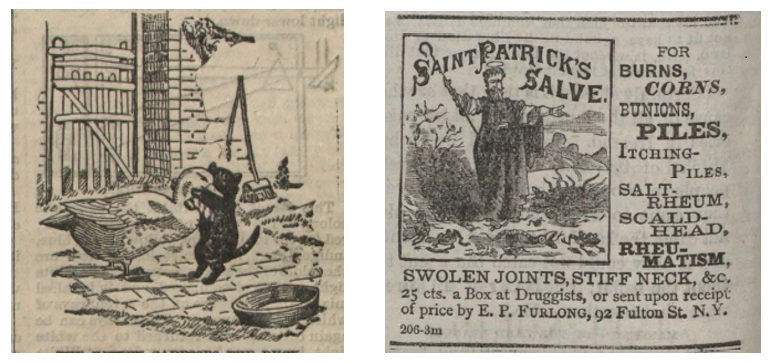
An image from the children’s column and an advertisement for ‘Saint Patrick’s salve’
US News
There is much coverage of New York news, including features on local politics, elections, and Tammany Hall. Tammany Hall was a powerful political organisation allied with the Democratic Party. It came to be dominated by Irish Americans in the 19th century and was ruthless in its running of election campaigns. Shortly after arriving in New York O’Donovan Rossa ran in a state election against the infamous Tammany Hall politician William ‘Boss’ Tweed (1823-78). He lost after what was possibly a rigged count (Tweed was jailed not long after for stealing tens of millions of public funds).
Workers, not blowers, he said, were required in Saratoga
In one issue of the newspaper it was reported that there was an argument within the Tammany Hall Committee on Organisation about whether to send a special train and a band to a political convention in Saratoga. One member wanted to go in plain, democratic fashion. Some members were happy about the special train but not the band, with ex-coroner Waltman saying that “workers, not blowers, were required in Saratoga”. O’Donovan Rossa continued to take an interest in local and national politics, despite his experience. Though reluctant to align himself to any one party or political organisation he often made recommendations for individual candidates.
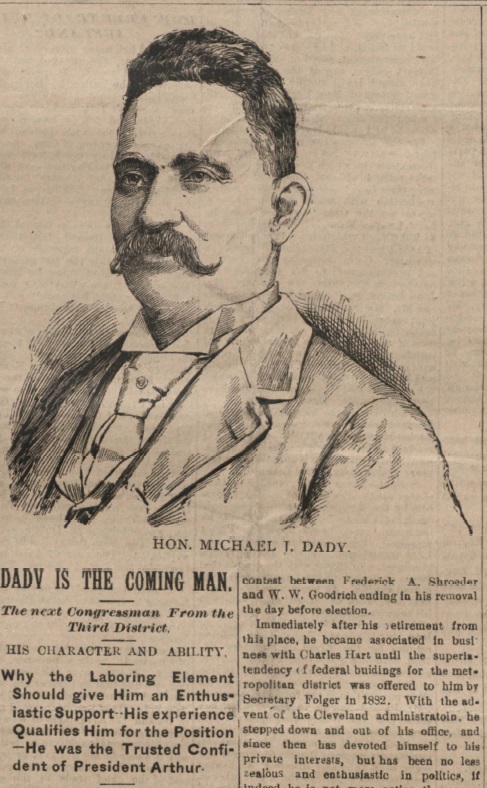
The newspaper often featured O’Donovan Rossa’s recommendations for political candidates, including this one for Michael J. Dady (1850-1921) in a congressional election, 29 October 1892
Irish News
Full pages are given over to Irish county news and articles about political events in Ireland and Britain. As O’Donovan Rossa watched from a distance, the 1880s saw a volatile blending of Irish nationalism and land agitation. Tenants organised to campaign for better rents or outright ownership of their farmland, prompting a decade of rent strikes, evictions, and violence.
Are there any ladies willing to become the Florence Nightingales of the Land League?
In London, the land question was taken up as part of the broader nationalist agenda of Parnell’s Irish Parliamentary Party. The government passed limited land reform acts, but the concurrent implementation of crime acts to suppress rural agitation and violence also resulted in many arrests (including that of Parnell himself), and ultimately served to worsen the situation.
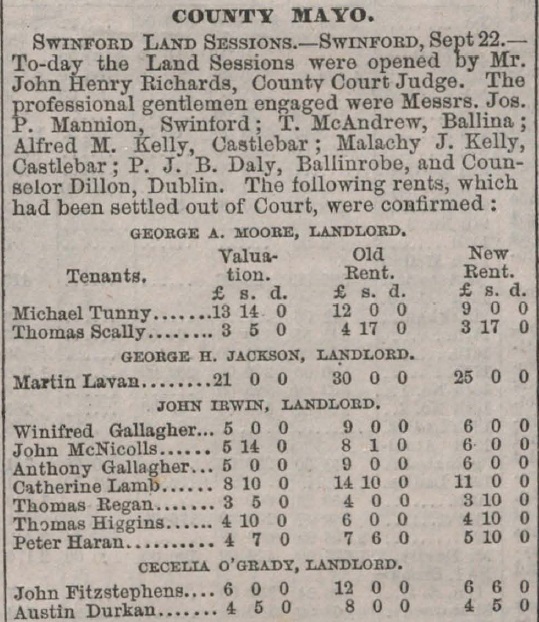
Reports to the newspaper provided updates from land sessions around Ireland
Many of the stories sent to The United Irishman were from local branches of the Land League and the Irish National League, reporting on the high levels of evictions, arrests, and court cases. In one published letter from 10 December 1881, Fanny and Anna Parnell (sisters of Charles), both based in the United States, sought to recruit women for the Ladies’ Land League in Ireland. Potential candidates were proposed "to have intelligence, physical strength, reliability, and a certain amount of education and refinement, being not too young", and all expenses would be paid for the work.
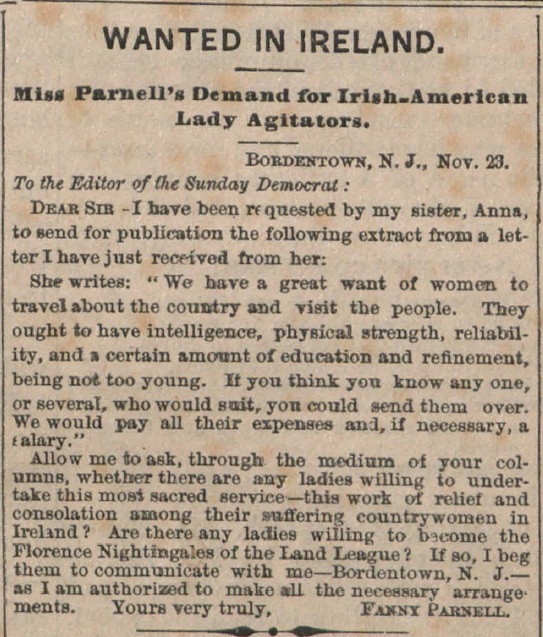
Rossa printed this recruitment message for the Ladies’ Land League in 1881
There were also regular lists of marriages and deaths in Ireland. Together with the numerous letters in the newspaper, they provide the names and locations of many hundreds of people in Ireland and the United States over this two-decade period.
The Immigrant Experience
The newspaper depicts a great spectrum of experience for Irish immigrants. There were occasional messages from Irish people looking for loved ones who had disappeared years before. One message from 17 December 1881 asked readers to look in on an Irish couple who had been found in a starving condition in a room at the rear of no. 434 East Ninth Street.

The newspaper sometimes featured letters from Irish people searching for family members
This contrasts with the more communal social experiences of Irish immigrants at numerous festivals, concerts, balls, picnics, and St. Patrick’s Day parades. O’Donovan Rossa and his wife Mary Jane were guests at many of the events and made some money from readings and lectures. But the sheer prevalence of such events reported and promoted in the paper also shows the strong social and cultural bond that existed among the new Irish American community.
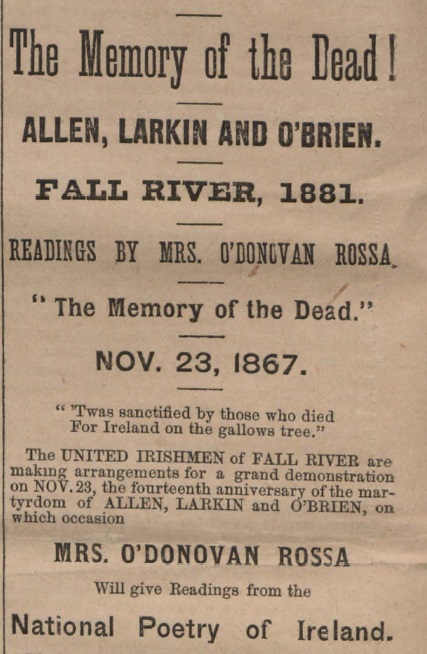
Readings and lectures promoted by the United Irishman often featured accounts of historical nationalist figures and events
Irish Culture
Though often highly personalised in terms of content, the newspaper also sits within the broader ‘Gaelic revival’ of the late 19th century. This was a time when Irish traditional Gaelic culture - art, literature, music, sport, etc. – and the Irish language were heavily promoted after centuries of decline under British rule. The newspaper features poetry and ballads throughout. Some are original, by the editor himself or other contributors, and people often included poems in their own letters. O’Donovan Rossa also took requests from people to publish their favourite poems.
You ought to advise the Irish to quit writing poetry altogether.
The prevalence of poems in the first year of the newspaper’s publication prompted a letter from W.G. in Houston, who said that notwithstanding his support for the paper “would it not be better if you were to cease publishing poetry entirely in its columns?... You ought to advise the Irish to quit writing poetry altogether. I believe it would be more to their credit to have less of it published. A battle-song now and then would do well enough; but nine-tenths of what is now written is balderdash, gush, which is calculated to detract from the character of the race who indulge in it”.
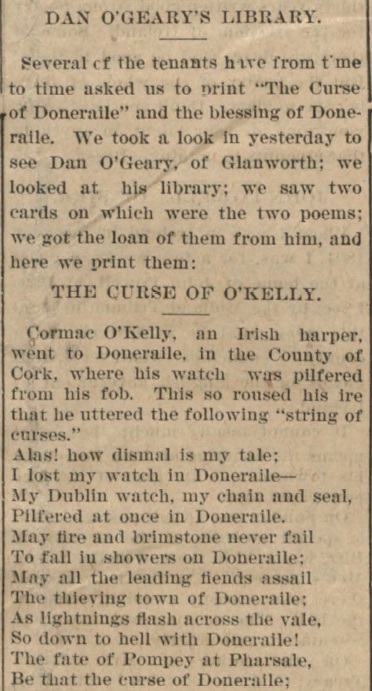
'The Curse of Doneraile’ was a popular request in the newspaper
The United Irishman regularly promoted the Irish language, with O’Donovan Rossa (a fluent Irish speaker) writing early into the paper’s run that he regretted not being able to use the traditional letters. “But”, he concluded, “we don’t love a man according to the sort of clothing he wears, and if we love the Irish language, we will love it in Roman dress as well as its own”.
What a terrible brogue he has
O’Donovan Rossa published advertisements for Irish language societies, lessons, and publications for learning the language, as well as articles featuring the work of renowned Irish language scholar John O’Donovan.
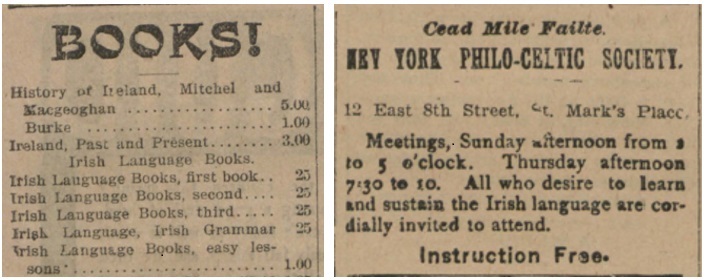
O’Donovan Rossa sold Irish language books directly and promoted Irish language classes
There was also an account in an issue from 31 March 1888, of an address at a public dinner where O’Donovan Rossa remarked that “Gaelic was his language, the English was a foreign tongue to him. He had tried hard to learn it, but he had given up for good many years ago the hope of being able to properly express himself in it. He was reminded very forcibly of his failure, one evening coming out of a theatre in Detroit, when he heard a woman remark 'What a terrible brogue he has'".
Irish Unity
The United Irishman shares many similarities to other Irish American newspapers of the late 19th century. This was a time when newspapers shared titles, and editors and writers shared content with each other (officially and unofficially).
Success in all movements, social, national and political, is only attained by union
But the newspaper is special, simply because of who O’Donovan Rossa was and his role in the Irish nationalist movement. O’Donovan Rossa used his newspaper to promote a violent campaign for Irish independence. He also used the newspaper to maintain a strong cultural bond between the Irish communities on both sides of the Atlantic, through the publication of news, letters, marriages and deaths, and the promotion of Irish social events.
The newspaper displays a significant fusion of culture and politics. “Success in all movements”, O’Donovan Rossa claimed, “social, national and political, is only attained by union”. And his newspaper was a site of union, a place where, he believed, he could “cement” the scattered millions of Irish people now rooted all over the world.
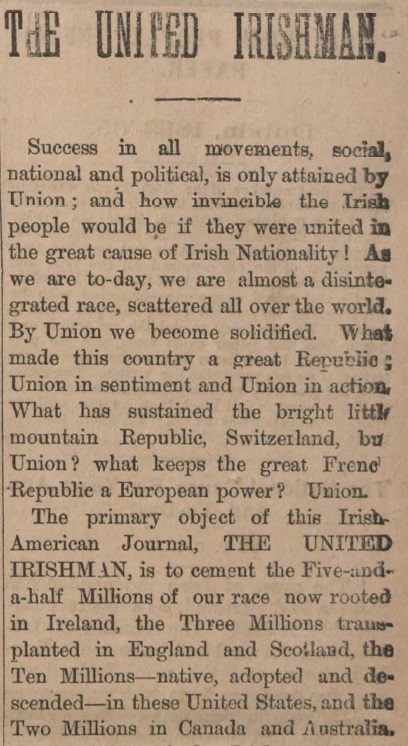
O’Donovan Rossa’s stated purpose for his Irish-American journal, 19 November 1881
About the library’s digital collections
The United Irishman newspaper has been fully digitised by the Oireachtas Library and can be viewed at https://opac.oireachtas.ie.
The Oireachtas Library has been running an extensive programme since 2009 to digitise its historical collections, making over 12,000 documents available to the public. This newspaper is from the Dublin Castle collection. Dating from the late 16th century, this is the largest collection in the library’s holdings, containing a wide variety of books, pamphlets, periodicals, and unique archival material that was once housed in the Chief Secretary’s Office in Dublin Castle.
References
Kenna, S. (2015). Jeremiah O’Donovan Rossa: Unrepentant Fenian. Merrion Press.
Ó Lúing, S. (2016). O’Donovan Rossa: An Irish Revolutionary in America (P. McWilliams, Trans.). Nuascéalta. (Original work published 1969).

